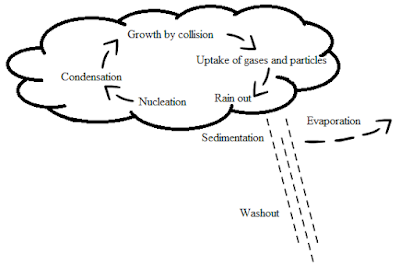While I was writing my
first article, I noticed that there were almost no models that describe how the radioactive fallout settles to the ground (or deposits, as they say). The models that I found were either extremely primitive or simply mathematical fittings to data, with next to none predictive power!
The crudest model is that you take the radioactive concentration (Becquerel/cubic meter) and multiply it with the amount of rain (millimeters). I have no idea what motivated this (maybe that the dimensions work out to be correct?), and it's just as reliable as it sounds.
The most advanced model I found was actually quite reliable in estimating deposition, but as it was just a mathematical fit to measured data, it did not offer any insight to the physics behind it.
So, I started drafting a simple model to introduce in the first paper. I had a small notebook where I would scribble whatever I had come up with. The notebook filled up quickly and I realized that there was no way I could fit all this into the first paper.
And there was also the issue that I needed to get my master's thesis done so I ended up making it about radioactive deposition, although I was majoring in photonics. Later on, I refined the text in my thesis so that it would be publishable and send it to a journal.
The main idea was to calculate the deposition from first principles and end up with a physical, highly predictive deposition model. This was quite easily achieved for dry deposition (particles that settle to the ground without assistance from rain).
Wet deposition (particles that are pushed to the ground by rain) was another matter. The processes that describe the probability of a particle being scavenged are really complex and there are a lot of them. I really didn't feel like taking all of them into account.
I decided that I would make an approximation: take all the processes together as chaotic and then just say that if a particle is hit by a droplet, it goes all the way to the ground with it. This is of course not exactly true, but it was good enough for my purposes. Then how do you calculate such probability?
You take the limiting case: a single point like particle in one cubic meter of air and how much does it need to rain for it to be hit by the water drops with 100 % certainty. And when does that happen? When the whole cubic meter is full of water.
Unsurprisingly, it turns out that the intensity of rain has to be absolutely ludicrous for this to happen, about 11 km/h (violent rain is classified as being 50 mm/h). Good for us that that is not actually possible!
Anyway, taking into account that there were some approximations and empiricism involved, the model served its purpose quite well and it predicted the actual deposition nicely.



Comments
Post a Comment